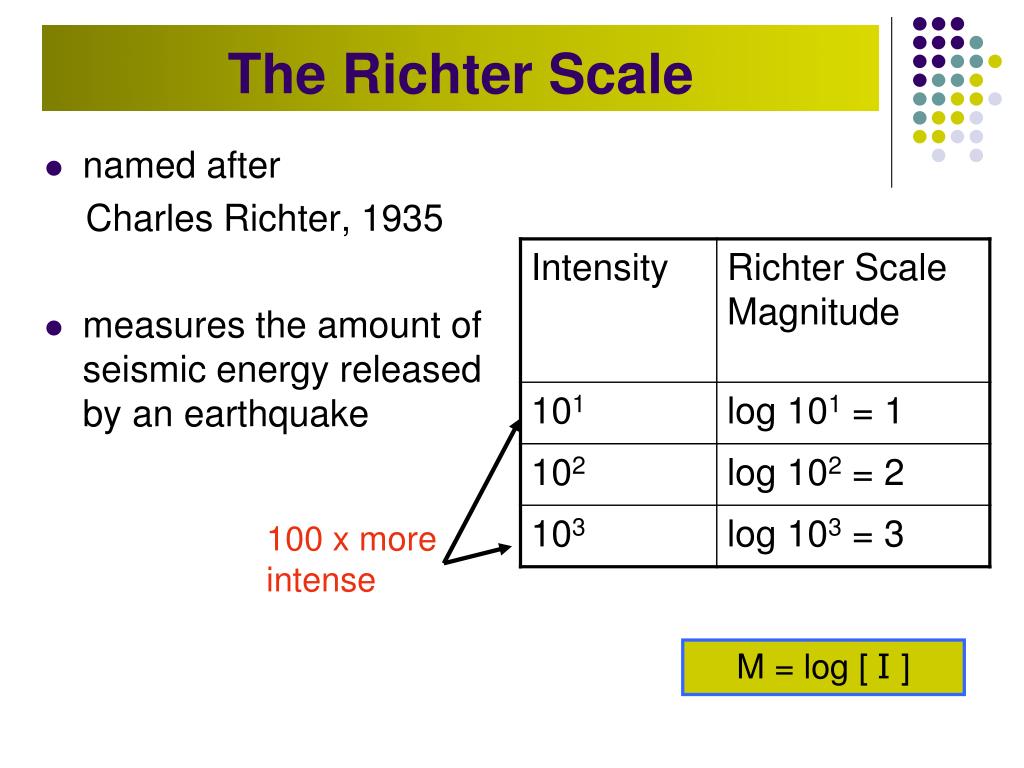Earthquake Scale Logarithmic | Compare the energy of this earthquake to that of the 2003 earthquake that destroyed the ancient city of bam, iran, which had magnitude 6.3 and killed an estimated 50,000 people. The magnitudes jump from one level to the next. Logarithmic scale (algebra 2 level). A logarithmic scale is a scale used when there is a large range of quantities. Common uses include earthquake strength, sound loudness, light intensity, spreading rates of epidemics, and ph of solutions. Earthquakes happen often but most are too small for us to notice. In order to easily manage and represent the wide range of ion activities, a logarithmic ph scale is used. A logarithmic scale is a scale used when there is a large range of quantities. Applications of logarithmic equations : The logarithmic magnitude scale is confusing to many, but it's here to stay. This is a logarithmic scale, where each step has ten times the power of the previous one. It explains when logarithmic graphs with base 2 are preferred to logarithmic graphs with base 10. The richter magnitude scale (also richter scale) assigns a magnitude number to quantify the size of an earthquake. This video shows how to compare the richter scales of different earthquakes using logarithms. A logarithmic scale is a scale used when there is a large range of quantities. Richter scale definition facts britannica. Actual observation of the earthquake. This is a logarithmic scale. A logarithmic scale (or log scale) is a way of displaying numerical data over a very wide range of values in a compact way—typically the largest numbers in the data are hundreds or even thousands of times larger than the smallest numbers. A logarithmic (or just log) scale has unevenly spaced grid lines. This post offers reasons for using logarithmic scales, also called log scales, on charts and graphs. The mercalli intensity scale describes earthquake intensity. There are many problems with the mercalli scale. Other scales, based on wave amplitudes and total earthquake duration, were developed for magnitudes are based on a logarithmic scale (base 10). The richter magnitude scale (often shortened to richter scale) is the most common standard of measurement for earthquakes. That scale was specific to california earthquakes; An earthquake or earth vibration [greek. Earthquakes happen often but most are too small for us to notice. The richter magnitude scale (also richter scale) assigns a magnitude number to quantify the size of an earthquake. I've been doing a bunch of videos about logarithmic scale and we've also unfortunately had many notable earthquakes this. This is a logarithmic scale. The richter scale is logarithmic. An earthquake or earth vibration [greek. Using logarithms, the richter scale measures an earthquake relative to (as a ratio of) the weakest possible tremor. Actual observation of the earthquake. Download and use 800+ earthquake scale logarithmic stock photos for free. Other scales, based on wave amplitudes and total earthquake duration, were developed for magnitudes are based on a logarithmic scale (base 10). This post offers reasons for using logarithmic scales, also called log scales, on charts and graphs. A logarithmic (or just log) scale has unevenly spaced grid lines. A logarithmic scale (or log scale) is a way of displaying numerical data over a very wide range of values in a compact way—typically the largest numbers in the data are hundreds or even thousands of times larger than the smallest numbers. How are earthquakes measured you ll remember quizlet. The magnitudes jump from one level to the next. Logarithmic scale magnitude alaska earthquake intensity tsunami application youtube. Applications of logarithmic equations : A logarithmic scale is a nonlinear scale often used when analyzing a large range of quantities. In order to easily manage and represent the wide range of ion activities, a logarithmic ph scale is used. Because the richter scale is logarithmic, a 5.0 earthquake this is because the mercalli scale relies on witnesses to report about the earthquake, so the quake's force is not defined in rigorous and. It explains when logarithmic graphs with base 2 are preferred to logarithmic graphs with base 10. That scale was specific to california earthquakes; A logarithmic scale is a scale used when there is a large range of quantities. This is a logarithmic scale, where each step has ten times the power of the previous one. The complexity at the source and in the earth materials through which the. Applications of logarithmic equations : The richter magnitude scale (often shortened to richter scale) is the most common standard of measurement for earthquakes. A logarithmic (or just log) scale has unevenly spaced grid lines. The mercalli intensity scale describes earthquake intensity. The magnitudes jump from one level to the next. Using logarithms, the richter scale measures an earthquake relative to (as a ratio of) the weakest possible tremor. Learn to interpret math questions dealing with earthquakes with our guided examples and test your learning.


How are earthquakes measured you ll remember quizlet earthquake scale. Large earthquakes are usually connected with plate boundaries.
Earthquake Scale Logarithmic: This post offers reasons for using logarithmic scales, also called log scales, on charts and graphs.